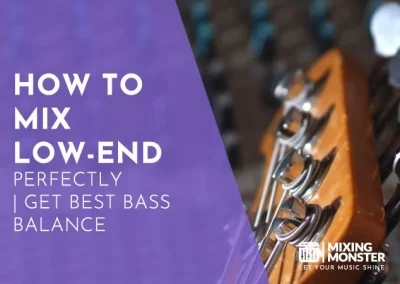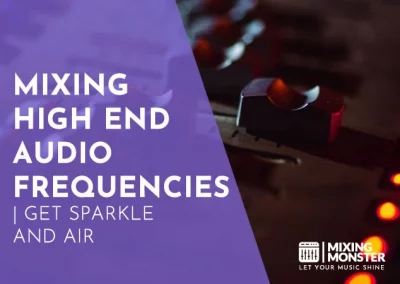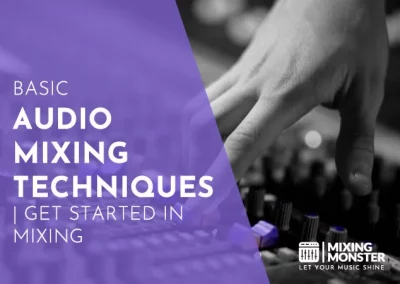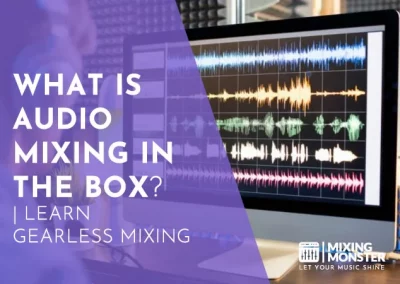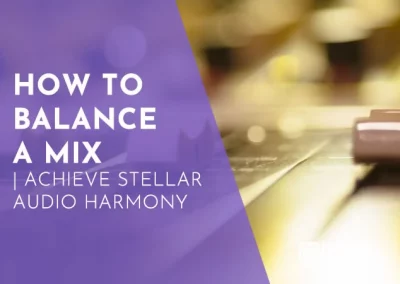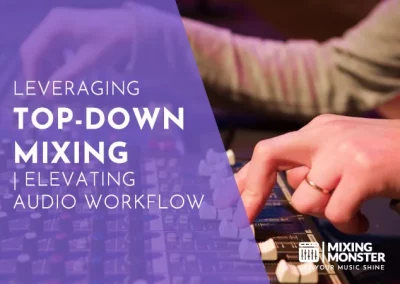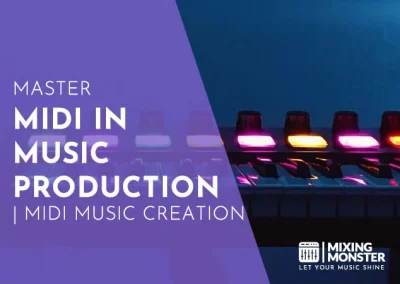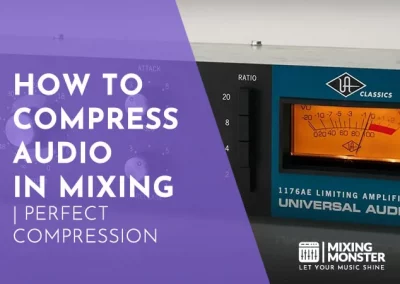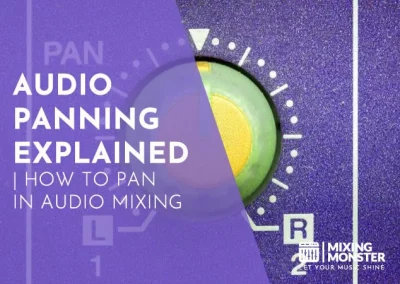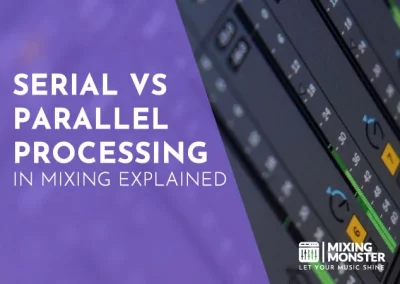Home > Blog > Mixing > Mixing Techniques
Disclosure: Some of the links below are affiliate links, meaning that at no additional cost to you, we will receive a commission if you click through and make a purchase. Read our full affiliate disclosure here.
Mastering the art of midrange mixing can elevate your audio productions from amateur to professional. The crucial process balances frequencies most prominent to human hearing, ensuring clarity and presence in your mix.
Midrange frequencies typically range from 200Hz to 4kHz and are where the critical elements of a mix, like vocals and rhythm guitars, live. Properly managed midrange ensures that these vital components of a song find their place without competing with each other, enabling a clear and balanced mix. By carefully controlling these frequencies, you can significantly improve the intelligibility and impact of your mix.
However, achieving the perfect midrange balance can be complex, often requiring a deep understanding of equalization and compression to address common challenges that mix engineers face. As you dive deeper into your mixing journey, you’ll encounter advanced techniques to make or break your midrange mix.
You’ll learn to analyze the elements contributing to mud and honk and apply focused EQ tweaks and compression strategies to create a polished end product. Get ready to transform your knowledge into action, crafting mixes that stand out in today’s competitive music landscape.
KEY TAKEAWAYS:
- Midrange mixing is vital to achieving a clear and present sound in your production.
- Proper midrange handling includes balancing elements and using EQ and compression.
- Advanced techniques and genre-specific considerations are crucial for a polished mix.
Table Of Contents
1. Midrange Frequencies Explained
2. Common Challenges With Midrange Mixing
3. Analyzing Midrange Elements
4. Advanced EQ Techniques For Midrange
5. Compression Strategies For Midrange Control
6. Genre-Specific Midrange Mixing Considerations
7. Creative Use Of Effects In Midrange
8. Best Practices For Midrange Mixing
9. Finalizing Your Midrange Mix
10. Recap Of Midrange Mixing Strategies
11. FAQ

1. Midrange Frequencies Explained
Midrange frequencies are vital in mixing as they shape the clarity and presence of your audio, particularly in music and voice.
Defining Midrange In The Audio Spectrum
Midrange frequencies constitute a critical band within the audio spectrum where much of the content that makes up the tonal character of musical instruments and the human voice resides. Here’s a simplified breakdown of the midrange frequency ranges:
| Frequency Range (Hz) | Descriptor |
|---|---|
| 250 – 500 | Low Midrange |
| 500 – 2,000 | Midrange |
| 2,000 – 4,000 | Upper Midrange |
| 4,000 – 6,000 | High Midrange |
Midrange encompasses fundamental frequencies of instruments and the human voice and critical harmonics that contribute to their timbre and recognition.
The Role Of Midrange Frequencies In Music And Speech
Midrange frequencies play a pivotal role; they allow the distinction of different voices and instruments in a mix. This range is essential for achieving a balanced, transparent sound and ensuring that your mix translates well across different listening environments.
For speech, midrange frequencies provide intelligibility and naturalness—your ears are astutely sensitive to this frequency range because it aligns with the fundamental frequencies of speech. Getting your midrange right in music means that the essential elements, like vocals or guitar riffs, sit well in the mix without overpowering other frequencies.
2. Common Challenges With Midrange Mixing
Midrange frequencies are critical to the clarity of your mix. They can quickly become muddled or harsh, making it imperative to recognize and address these issues promptly.
Identifying Midrange Muddiness And Harshness
Midrange muddiness often arises when instruments that share similar frequency spectrums overlap, leading to a mix that needs more clarity and clarity. To pinpoint muddiness, listen for a lack of separation between elements like the vocals and rhythm guitars, which should sit distinctly in the mix.
Identifying harshness requires careful listening for frequencies that cause listener fatigue, often found in the presence range of vocals or the attack of snare drums.
Problems Associated With Overcrowded Midrange
A crowded midrange poses distinct problems, as this frequency range is typically where many instruments compete for space. Addressing a crowded midrange involves strategic EQ-ing to carve out frequencies and allow each instrument to breathe.
It can lead to an overwhelming mix and difficulty listening if left unmanaged. You aim to achieve a balanced sound where each part maintains its distinct character without stepping on the others.
3. Analyzing Midrange Elements
In this section, you will gain insights into the specific components of the midrange frequencies and understand how they interact with different elements of your mix, especially instruments and vocals, and the influence of room acoustics.
Breaking Down Instruments And Vocals In The Midrange
Your mix heavily relies on the midrange, which includes the core frequencies where most instruments and vocals lie. Instruments like guitars, pianos, and violins have fundamental tones and harmonics within this spectrum.
Similarly, vocals, which command attention in a mix, sit predominantly in the midrange. To achieve a balanced mix, assess how these elements overlap and interact. Precise EQ adjustments can separate competing frequencies, making each instrument and the vocals distinct and clear.
Example:
- Piano:
Cuts in the lower midrange can reduce muddiness. - Guitar:
Boosts around 2-4 kHz and enhances presence without clashing with vocal harmonics. - Vocals:
A slight reduction in the 1 kHz area can mitigate boxiness, increasing clarity.
The Impact Of Room Acoustics On Midrange
The acoustics of your room can significantly impact the midrange, often coloring the sound in ways that can either enhance or detract from a mix. It would be best to recognize how sound reflections and absorptions affect midrange frequencies to make informed mixing decisions.
For example, hard surfaces may cause specific midrange frequencies to be overly pronounced due to reflections, while heavy carpeting could absorb and dampen these same frequencies.
Strategies:
- Utilize acoustic treatment to minimize unwanted reflections.
- Test your mix in different listening environments to identify discrepancies in the midrange balance.
- Regularly calibrate your monitoring setup to ensure accurate midrange reproduction.
4. Advanced EQ Techniques For Midrange
Advanced EQ techniques can offer greater clarity and separation in mastering the midrange of your mix. Below, discover focused strategies to refine your tracks with precision.
Surgical EQ Tips For Clarity And Separation
When aiming for clarity in the midrange, surgical EQ is a precise tool. It allows you to carve out frequencies that are muddying your mix. Identify competing elements—two instruments fighting for the same frequency space can lead to a cluttered sound.
- Notch out unwanted frequencies by creating narrow EQ cuts. This helps to bring forth the desired instrument.
- Use high-Q values for precise adjustments, ensuring you only affect the problematic frequencies, not the surrounding ones.
Listening for masking issues is critical; applying these surgical cuts typically resolves muddiness and improves separation between elements in your mix
Using Dynamic EQ For Managing Midrange
Dynamic EQ provides a less static approach towards EQ adjustments—it acts like a hybrid of traditional EQ and compression. Your application of dynamic EQ should be musical and responsive to the track’s energy.
- Set thresholds to target specific midrange frequencies that become overbearing at certain moments.
- Apply gain reduction only when these frequencies exceed your threshold, ensuring that EQ moves dynamically with the performance.
This method not only maintains midrange clarity but also preserves the natural character of your instruments. You maintain balance and expressiveness in your mix by dynamically managing your midrange.

5. Compression Strategies For Midrange Control
Effective midrange control is critical for a well-balanced mix, and compression plays a pivotal role in achieving it. Let’s explore targeted strategies to harness the power of compression for refining midrange frequencies.
The Role Of Compression In Midrange Balancing
Compression is your ally in maintaining a steady dynamic range within the midrange, which often carries the crucial elements of your track. Applying compression to the midrange helps ensure that vocals, guitars, and other central instruments remain consistent and clear.
Balancing the dynamics of these elements prevents them from being drowned out or overwhelming other parts of the mix.
Multiband Compression For Complex Midrange Issues
A multiband compressor becomes crucial when standard compression isn’t nuanced enough to address specific problems. This type of compressor allows you to isolate and compress different frequency ranges independently.
- Attack And Release:
Fine-tune the attack and release settings to affect how quickly the compressor responds to the midrange frequencies. - Threshold:
Set the threshold to determine the point at which compression begins to engage on the midrange signals. - Ratio:
Adjust the ratio for the desired amount of compression applied once the signal exceeds the threshold.
In complex mixes, these parameters give you granular control over the midrange dynamics, ensuring each element sits perfectly within the mix.
6. Genre-Specific Midrange Mixing Considerations
When mixing music, the treatment of the midrange frequency spectrum can vary significantly across different genres. Your approach should be tailored to enhance the stylistic elements unique to each genre.
Adapting Midrange Techniques For Different Music Genres
In various music genres, the midrange plays a crucial role in defining the character of the sound. For instance, you would focus on maintaining the genre’s intensity in heavy metal while ensuring clarity among distorted guitars and aggressive vocal lines. The treatment often includes carving out space around the lead elements to allow them to cut through the mix.
Conversely, genres like jazz or acoustic music require a more subtle approach. Here, preserving the natural tone of instruments is key. You must meticulously balance frequencies to sustain warmth and detail, often requiring minimal EQ adjustments and careful compression to retain the dynamic range.
Midrange Treatment In Various Musical Contexts
The application of midrange EQ varies in different musical contexts. In a dense orchestral piece, midrange clarity helps to differentiate between the complex layers of instruments. Boosting the presence region around 1-3 kHz could add definition to strings and woodwinds.
When approaching pop or electronic dance music (EDM), the objective is to achieve a polished sound where synths and vocals share the spotlight; this often means sculpting the midrange to prevent frequency masking among leads, chords, and the rhythm section.
Applying stereo imaging techniques can exploit the entire stereo field for a more comprehensive sound. In the context of R&B or soul, for instance, spreading out backing vocals or keys in the midrange can enhance the immersive quality of the mix. Each genre demands specific midrange treatments that align with its musical objectives, requiring you to adjust your mixing strategy accordingly.
7. Creative Use Of Effects In Midrange
In midrange mixing, the precise application of effects can elevate sound quality by enhancing the character and presence of the vital mid frequencies.
When And How To Use Reverb And Delay On Midrange Frequencies
- Reverb:
- Use Sparingly:
Adding too much reverb to midrange frequencies can cause muddiness. Apply it lightly to create depth without overpowering the mix. - Short Decay Times:
Opt for shorter decay times to ensure clarity and prevent the blurring of rhythmic elements. - Frequency-Specific Reverb:
Use a reverb send with an EQ to apply the effect only to certain midrange parts, avoiding the lower mids that can quickly become congested. - Delay:
- Subtle Echoes:
Use delay to add subtle repetitions that enhance the rhythm or melody without causing distraction. Tight, rhythmic delay patterns work well with the midrange. - Midrange Ducking:
Dialogue or vocals can benefit from delays ducked under the direct sound, providing thickness without competing for attention.
Saturation And Harmonic Excitement In Midrange
- Saturation:
- Warmth And Cohesion:
Introduce tube or tape saturation to add warmth and analog character to your midrange elements, making them sound more cohesive. - Controlled Drive:
Apply saturation with precision to avoid distortion. This can enhance harmonics and make your midrange sounds more pronounced in the mix. - Harmonic Excitement:
- Enhancing Presence:
Use harmonic exciters to enhance the upper midrange selectively, bringing vocals or lead instruments to the foreground. - Avoid Overuse:
Avoid overdoing it; too much harmonic excitement can lead to listener fatigue and harshness in your mix.
By thoughtfully applying reverb, delay, saturation, and harmonic excitement, you tailor the midrange to carry the expressive content of your music while maintaining overall balance and clarity.
8. Best Practices For Midrange Mixing
When tackling midrange mixing, it’s crucial to consider the subtleties that can make or break the balance of your mix. Employing precise techniques and keeping an ear out for clarity can yield a well-defined midrange against professional standards.
Mixing At Low Volumes For Better Midrange Decisions
Mixing at low volumes is essential for making accurate decisions regarding the midrange. It helps you gauge the balance of instruments without the interference of room acoustics that might color the sound at louder volumes. Furthermore, it prevents the early onset of ear fatigue, allowing you to make critical mix decisions for longer periods.
Best Practice Tip:
Start your mix at low levels and only periodically increase volume to check the overall mix balance.
The Importance Of Reference Tracks In Midrange Mixing
Utilizing reference tracks in midrange mixing can steer you toward the right balance between vocals and instruments. By comparing your mix to well-mixed tracks in the same genre, you get an objective benchmark for how your midrange stacks up.
Best Practice Tip:
Choose a few reference tracks renowned for their midrange quality and regularly switch between them and your mix to maintain a baseline for your sound.
| Best Practices For Midrange Mixing | Description |
|---|---|
| Set HPF and LPF appropriately | Use high-pass and low-pass filters to clean up unnecessary frequencies and make room for the midrange. |
| Check Midrange with Mono Compatibility | Sum your mix to mono to check for phase issues and ensure that the midrange elements are present and balanced. |
| Balance with EQ, not just volume | Adjust the equalization of your tracks to shape the midrange frequencies and achieve balance without over-relying on volume faders. |
| Compress Judiciously | Apply compression with care to maintain dynamic range while controlling the dominant midrange elements. |
| Reverb: Less is More | Use minimal, high-density reverb to cohesively blend midrange elements without muddying the mix. |
| Regular Breaks and Fresh Ears | Take frequent breaks to rest your ears, ensuring your decisions stay unbiased and accurate. |
Remember, the best practices in midrange mixing evolve around precision and objectivity. Trust your ears, use these tools wisely, and maintain a consistent approach to achieve a clear and balanced mix.
9. Finalizing Your Midrange Mix
As you approach the final stages of your mix, the midrange requires particular attention to ensure clarity and translation across different listening environments.
A/B Testing And Critical Listening Of The Midrange
A/B testing is crucial for assessing the midrange quality of your mix. Compare your mix to reference tracks known for their exemplary midrange treatment. Switch between your mix and the references frequently, listening for clarity, balance, and presence differences in the midrange. Make any necessary adjustments based on these comparisons.
Use high-quality monitors or headphones in an acoustically treated space for critical listening. Focus on the midrange frequencies—this is where vocal intelligibility, the body of guitars, and the punch of snare drums live. Ensure these elements are distinct and well-balanced within your mix. Also, listen at different volume levels; some midrange issues only become apparent when the volume is low.
Preparing For Mastering: Ensuring Midrange Translates Well
Before sending your recording off for mastering, test your midrange fares on different sound systems—from earbuds to car speakers. This diversity in testing environments can reveal inconsistencies and translational issues.
| Sound System | Observations | Adjustments Needed |
|---|---|---|
| Earbuds | Too harsh on vocals | Reduce upper mids |
| Car Speakers | Muddy guitar sounds | Scoop low mids slightly |
A proper midrange mix should sound good on all of these systems. If it doesn’t, go back and make subtle EQ adjustments until you achieve the best possible balance. Remember not to overprocess; the goal is to have a natural-sounding mix that mastering can refine and enhance, not fix.
10. Recap Of Midrange Mixing Strategies
Key Takeaways For Midrange Mixing
- Balance Is Crucial:
Ensure your mix doesn’t have too much or too little midrange. Too much energy can produce a harsh sound, while too little can make your mix feel hollow. Use techniques to adjust the EQ and apply bandpass filters effectively to find the right balance. - Clarity And Impact:
Optimize the 200Hz to 4k range to enhance transparency and impact. Attenuating or amplifying specific frequencies within this zone can bring forward vocals and lead instruments, ensuring they cut through the mix.
Experiment And Develop Personal Midrange Mixing Techniques
- Try Different Approaches:
Each mix is unique, so experiment with various EQ settings and listen critically to how they affect the overall sound. Adjusting frequencies around 800Hz specifically can make vocals more present. - Learn From Experience:
Refine your techniques over time. Record and revisit your adjustments during and after the mixing process to understand their impact and develop the best strategy for you and your projects.
Remember, these strategies are starting points. Your ears and musical intuition will guide you as you mix to achieve the best midrange sound for your track.
Midrange frequencies are crucial for the balance and clarity of a mix. Understanding their role and how to manage them can significantly improve your audio production!
Happy midrange mixing!
11. FAQ
1) How can I better understand the role of midrange frequencies in audio mixing?
Our ears are most sensitive in midrange frequencies, particularly the upper mids. They can carry the warmth of a vocal, a guitar’s body, or a piano’s attack. An overpowering midrange can make a mix sound harsh, while too little can leave it feeling hollow. Learning to adjust the midrange is a critical skill for any mixer.
2) What are the best practices for balancing midrange with bass and treble in a mix?
Achieving a balanced mix involves blending the midrange with bass and treble frequencies so that no range overwhelms the others. Use EQ to carve space for each element and wisely apply compression to control dynamics. This ensures that the midrange complements the full spectrum of sounds without dominating it.
3) Can you provide guidelines for EQing midrange frequencies when mixing music?
When EQing midrange, aim to cut or boost frequencies selectively to enhance clarity and coherence. For instance, a slight cut in the lower mids can reduce muddiness, while boosting the higher mids may add presence to vocals. Remember to make adjustments in the context of the entire mix, not just soloed tracks.
4) How does midrange presence affect the clarity and quality of a mix?
Midrange frequencies can bring forward the critical elements of a mix, like vocals and lead instruments. However, if the midrange is too dominant, it can cloud other frequencies, reducing clarity. Conversely, a strong midrange presence can result in a mix that needs more definition and punch.
5) How should midrange speakers be integrated into a full sound system setup?
Midrange speakers should be positioned to complement the other components of your sound system. They handle the essential frequencies that full-range speakers might miss. For optimal integration, ensure they’re phase-aligned and the crossover points are set correctly relative to other speakers in the system.
6) What common mistakes should be avoided when adjusting midrange during mixdown?
Avoid over-EQing the midrange, which can lead to an unnatural sound. Also, avoid neglecting the interaction between midrange and other frequency ranges, impacting the mix’s overall balance. Always make adjustments while listening to the mix to prevent frequency imbalances.


